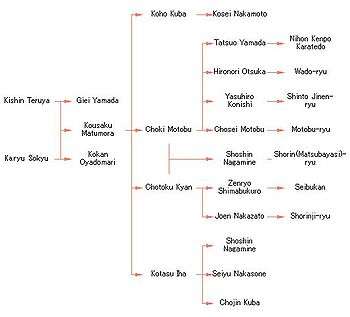Okinawan martial arts

Okinawan martial arts refers to the martial arts, such as karate, tegumi and Okinawan kobudō, which originated among the indigenous people of Okinawa Island.
Due to its central location, Okinawa was influenced by various cultures with a long history of trade and cultural exchange, including Japan, China and Southeast Asia, that greatly influenced the development of martial arts on Okinawa.
History
In 1429, the three kingdoms on Okinawa unified to form the Kingdom of Ryukyu. When King Shō Shin came into power in 1477, he banned the practice of martial arts. Tō-te and Ryukyu kobudō (weaponry) continued to be taught in secret.[1] The ban was continued in 1609 after Okinawa was invaded by the Satsuma Domain of Japan. The bans contributed to the development of kobudō which uses common household and farming implements as weaponry. The Okinawans combined Chinese martial arts with the existing local variants to form Tōde (唐手 Tuudii, Tang hand, China hand), sometimes called Okinawa-te (沖縄手 Uchinaa-dii).[2]
By the 18th century, different types of Te had developed in three different villages – Shuri, Naha and Tomari. The styles were named Shuri-te, Naha-te, and Tomari-te, respectively.
Well into the 20th century, the martial arts of Okinawa were generally referred to as te and tii 手 in Japanese and Okinawan for "hand". Te often varied from one town to another, so to distinguish among the various types of te, the word was often prefaced with its area of origin; for example, Naha-te, Shuri-te, or Tomari-te.
Shuri-te, Naha-te and Tomari-te belong to a family of martial arts that were collectively defined as Tode-jutsu or To-de.[3][4]
Karate (Okinawa-te or Karate-jutsu) was systematically taught in Japan after the Taisho era (after 1926).[5]
Shuri te


Shuri-te (首里手, Okinawan: Suidii) is a pre-World War II term for a type of indigenous martial art to the area around Shuri, the old capital city of the Ryukyu Kingdom.
Important Okinawan masters of Shuri-te:
- Yamaza Bin Yamazu
- Sakukawa Kanga
- Matsumura Sōkon
- Itosu Ankō
- Asato Ankō
- Chōyū Motobu
- Motobu Chōki
- Yabu Kentsū
- Chōmo Hanashiro
- Funakoshi Gichin
- Kyan Chōtoku
- Chibana Chōshin
- Mabuni Kenwa
- Tōyama Kanken
- Tatsuo Shimabuku
Important kata:
The successor styles to Shuri-te include Shotokan, Shitō-ryū, Shōrin-ryū, Shudokan, Shōrinji-ryū, Gensei-ryu and Motobu-ryū.
Tomari-te

Tomari-te (泊手, Okinawan: Tumai-dii) refers to a tradition of martial arts originating from the village of Tomari, Okinawa.
Important Okinawan masters of Tomari-te:
- Yamaza Bin Yamazu
- Matsumora Kōsaku
- Oyadomari Kokan
- Motobu Chōki
- Kyan Chōtoku
Important kata:
- Naihanchi (Koshiki)
- Eunibu
- Rōhai
- Wanduan
- Passai (Tomari)
- Chinsu
- Chinpu
- Wankan
- Wanshū
- Seisan
- Jumu
- Nichin
- Juma
The successor styles to Tomari-te include Wado-ryu, Motobu-ryū, Matsubayashi-ryu and Shōrinji-ryū
Naha-te

Naha-te (那覇手, Okinawan: Naafa-dii) is a pre-World War II term for a type of martial art indigenous to the area around Naha, the old commercial city of the Ryukyu Kingdom and now the capital city of Okinawa Prefecture.
Important Okinawan masters of Naha-te:
- Yamaza Bin Yamazu
- Arakaki Seishō
- Higaonna Kanryō
- Miyagi Chōjun
- Kyoda Jūhatsu
- Mabuni Kenwa
- Uechi Kanbun
Important kata:
The successor styles to Naha-te include Gōjū-ryū, Uechi-ryū, Ryūei-ryū, Shito-ryu and Tōon-ryū.
See also
References
- ↑ Okinawan Masters. msisshinryu.com. Retrieved on 2011-06-20.
- ↑ Higaonna, Morio (1985). Traditional Karatedo Vol. 1 Fundamental Techniques. pp. 18–19. ISBN 0-87040-595-0.
- ↑ "Tomari-Te: The Place of the Old To-De". Retrieved July 25, 2005.
- ↑ "Koshinrin School of Karate: Katas". Retrieved July 25, 2005.
- ↑ Donn F. Draeger (1974). Modern Bujutsu & Budo. Weatherhill, New York & Tokyo. Page 125.